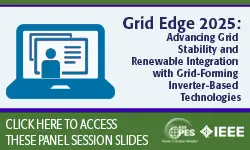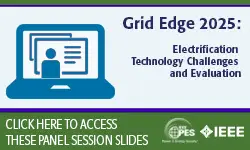-
Members: FreePES
IEEE Members: $25.00
Non-members: $40.00Pages/Slides: 83
Panel
13 Sep 2022
This panel session contains the following presentations:
1. Optimal Design of Green Energy Hub Considering Multi-Generation Energy Storage System
Based on the net-zero greenhouse gas emissions roadmap by 2050 under Paris Agreement, proposing new structures for energy systems is so vital with the aim of increasing renewable resources penetration in the energy generation sector. In this regard, energy sector coupling, as well as integration of different energy networks, can play a key role in the green energy transition. In this paper, a novel structure for a local multi-generation energy system (MGES) is investigated by considering the smart energy hub (SEH) concept. The proposed SEH supplies local energy demands through a hybrid renewable energy system, hybrid energy storage system, hybrid energy conversion system, and upstream energy networks. Moreover, high-temperature heat and power storage (HTHPS) unit has been introduced to support the network integration. To achieve optimal sizing of the proposed energy hub, an optimization problem is developed as mixed-integer linear programming (MILP) and solved using the Pyomo package in Phyton. Finally, the performance of the designed SHE is perused by applying different cases and its effectiveness is shown in reaching the designing criteria.
2. Accurate Regulation of the Power Output of a Two-Stage Photovoltaic System with Minimal Local Energy Storage
The conventional maximum power point tracking controllers are being replaced with the flexible power point tracking (FPPT) controllers to overcome the issues associated with the excess photovoltaic (PV) power production. The FPPT controller adjusts the PV array power output in accordance with the user specified reference power command (RPC). However, the PV array power output may not be adjusted precisely at the specified RPC because of the duty ratio quantization problem. As a result, there would be some power tracking error between the actually specified RPC and the tracked PV array output power. The power tracking error on the PV side eventually leads to a power tracking error on the grid side if no compensation is made. The main objective of this paper is to reduce the power tracking error on the grid side by compensating the power tracking error on the PV side with the help of a low capacity local energy storage system. A coordinated control strategy between the FPPT control and the local energy storage control is developed to achieve the specific objective. The efficacy of the proposed control strategy is verified using the MATLAB simulation studies, and the results are presented.
3. Investigation of Power Electronics Converters and Architecture for Modular HVDC Wind Generators
The objective of this paper is to investigate suitable topologies for the converter modules and architecture design of a modular High-Voltage Direct Current (HVDC) generator for offshore wind energy applications. The HVDC transmission has technical and economic advantages for offshore applications due to the distance between the wind farm and the coast. However, with the current wind farm configurations, it would still be necessary to use transformers and AC/DC converters to condition the Alternating Current (AC) power at the output of the generators into DC power and with high voltage values. Therefore, a modular generator architecture is proposed that directly produces HVDC power at its output using an electronic converter interface by the connection in series of modules of a segmented HVDC generator. The evaluation of converter topologies was performed through parameters such as reliability, controllability, loss, complexity, power quality, and component count. As a result, the Vienna rectifier proved to be a strong candidate for further study due to its low complexity, high power quality and low active switch count.
4. Relay Protection Test Challenges in Smart Grid DER
With the significant increase of Distributed Energy Resources (DER) at the same time as large generation plants are phased out reducing the mechanical system inertia, the future smart grid introduces new challenges which also affect relay protection and their relay test equipment. Two of the main concerns, to maintain network frequency stability and cost-effective relay protection, and how that drill down to make an impact of relay tests and test equipment will be covered in this paper. With network stability as highest priority, the International Electrotechnical Commission (IEC) released a new standard, IEC 60255-181:2019, where the focus is on frequency protection functions including Rate of Change of Frequency (ROCOF). The 1st part of this paper covers the impact of this standard on test methodologies and in the extension of that, also how it impacts the test equipment. The 2nd part covers briefly why Self-Powered Relays (SPRs) are a cost-effective solution, why they are a challenge to test even though they in general have basic protection functions and the solution to this problem. The 3rd part describes a practical example detailing on what is tested from a relay protection perspective on solar farms in Asia/Pacific (APAC) and argue what a cost-effective solution is for this.
5. Design of an Off-Grid Hydro-Solar-Biogas Energy System for Sustainable Energy Supply in Rural Communities
Renewable energy sources have been identified as the most feasible sustainable energy option for remote rural communities. A sharp decrease of prizes of these renewable energy technologies have made them to be economically attractive. This paper presents an off-grid hybrid energy system for sustainable energy supply in a remote rural community. A hydropower system is already installed in the considered rural community. The research study main objective is to show the advantage of using different renewable energy sources to complement the hydropower system when supplying the community load. The hydropower system is always connected in the system simulation and additional solar PV, biogas generator and a battery bank is included in the hybrid energy system optimization. System optimization is done using HOMER Pro software. The results show that it is feasible to complement different renewable energy sources depending on their availability. The cost of energy for the proposed hybrid energy cost is $0.67 per kWh.
1. Optimal Design of Green Energy Hub Considering Multi-Generation Energy Storage System
Based on the net-zero greenhouse gas emissions roadmap by 2050 under Paris Agreement, proposing new structures for energy systems is so vital with the aim of increasing renewable resources penetration in the energy generation sector. In this regard, energy sector coupling, as well as integration of different energy networks, can play a key role in the green energy transition. In this paper, a novel structure for a local multi-generation energy system (MGES) is investigated by considering the smart energy hub (SEH) concept. The proposed SEH supplies local energy demands through a hybrid renewable energy system, hybrid energy storage system, hybrid energy conversion system, and upstream energy networks. Moreover, high-temperature heat and power storage (HTHPS) unit has been introduced to support the network integration. To achieve optimal sizing of the proposed energy hub, an optimization problem is developed as mixed-integer linear programming (MILP) and solved using the Pyomo package in Phyton. Finally, the performance of the designed SHE is perused by applying different cases and its effectiveness is shown in reaching the designing criteria.
2. Accurate Regulation of the Power Output of a Two-Stage Photovoltaic System with Minimal Local Energy Storage
The conventional maximum power point tracking controllers are being replaced with the flexible power point tracking (FPPT) controllers to overcome the issues associated with the excess photovoltaic (PV) power production. The FPPT controller adjusts the PV array power output in accordance with the user specified reference power command (RPC). However, the PV array power output may not be adjusted precisely at the specified RPC because of the duty ratio quantization problem. As a result, there would be some power tracking error between the actually specified RPC and the tracked PV array output power. The power tracking error on the PV side eventually leads to a power tracking error on the grid side if no compensation is made. The main objective of this paper is to reduce the power tracking error on the grid side by compensating the power tracking error on the PV side with the help of a low capacity local energy storage system. A coordinated control strategy between the FPPT control and the local energy storage control is developed to achieve the specific objective. The efficacy of the proposed control strategy is verified using the MATLAB simulation studies, and the results are presented.
3. Investigation of Power Electronics Converters and Architecture for Modular HVDC Wind Generators
The objective of this paper is to investigate suitable topologies for the converter modules and architecture design of a modular High-Voltage Direct Current (HVDC) generator for offshore wind energy applications. The HVDC transmission has technical and economic advantages for offshore applications due to the distance between the wind farm and the coast. However, with the current wind farm configurations, it would still be necessary to use transformers and AC/DC converters to condition the Alternating Current (AC) power at the output of the generators into DC power and with high voltage values. Therefore, a modular generator architecture is proposed that directly produces HVDC power at its output using an electronic converter interface by the connection in series of modules of a segmented HVDC generator. The evaluation of converter topologies was performed through parameters such as reliability, controllability, loss, complexity, power quality, and component count. As a result, the Vienna rectifier proved to be a strong candidate for further study due to its low complexity, high power quality and low active switch count.
4. Relay Protection Test Challenges in Smart Grid DER
With the significant increase of Distributed Energy Resources (DER) at the same time as large generation plants are phased out reducing the mechanical system inertia, the future smart grid introduces new challenges which also affect relay protection and their relay test equipment. Two of the main concerns, to maintain network frequency stability and cost-effective relay protection, and how that drill down to make an impact of relay tests and test equipment will be covered in this paper. With network stability as highest priority, the International Electrotechnical Commission (IEC) released a new standard, IEC 60255-181:2019, where the focus is on frequency protection functions including Rate of Change of Frequency (ROCOF). The 1st part of this paper covers the impact of this standard on test methodologies and in the extension of that, also how it impacts the test equipment. The 2nd part covers briefly why Self-Powered Relays (SPRs) are a cost-effective solution, why they are a challenge to test even though they in general have basic protection functions and the solution to this problem. The 3rd part describes a practical example detailing on what is tested from a relay protection perspective on solar farms in Asia/Pacific (APAC) and argue what a cost-effective solution is for this.
5. Design of an Off-Grid Hydro-Solar-Biogas Energy System for Sustainable Energy Supply in Rural Communities
Renewable energy sources have been identified as the most feasible sustainable energy option for remote rural communities. A sharp decrease of prizes of these renewable energy technologies have made them to be economically attractive. This paper presents an off-grid hybrid energy system for sustainable energy supply in a remote rural community. A hydropower system is already installed in the considered rural community. The research study main objective is to show the advantage of using different renewable energy sources to complement the hydropower system when supplying the community load. The hydropower system is always connected in the system simulation and additional solar PV, biogas generator and a battery bank is included in the hybrid energy system optimization. System optimization is done using HOMER Pro software. The results show that it is feasible to complement different renewable energy sources depending on their availability. The cost of energy for the proposed hybrid energy cost is $0.67 per kWh.
Chairs:
Haroon Rashid


